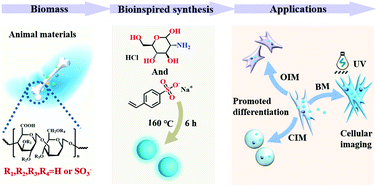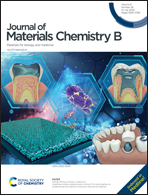Sulfonated glycosaminoglycan bioinspired carbon dots for effective cellular labelling and promotion of the differentiation of mesenchymal stem cells†
Abstract
Although carbon dots (CDs) have been synthesized and applied in a variety of biological fields, such as disease diagnosis and gene/drug delivery, the exploration of facile bioinspired synthesis and applications of CDs is still of great significance. Particularly, recent increasing research has clearly confirmed that nanomaterials can affect a series of physiological behaviors and functions of mesenchymal stem cells (MSCs) (e.g., differentiation and pluripotency). Therefore, it is very important to develop multifunctional nanomaterials to simultaneously realize the cellular labelling and regulation of MSC behaviors in practical applications. Herein, sulfonated glycosaminoglycan-bioinspired CDs as bi-functional nanomaterials were ingeniously designed for cellular imaging and promoting the differentiation of rat bone MSCs (rBMSCs) in different culture media, which simultaneously met the two fundamental requirements in the field of MSC-based treatments (e.g., precisely directing the differentiation of MSCs and effective cellular labeling). These bifunctional CDs were successfully prepared via one-pot hydrothermal synthesis by using D-glucosamine hydrochloride (GA·HCl) and sodium p-styrenesulfonate (NaSS) as the reactants. The synthesized CDs with a uniform particle size (around 4 nm) dispersed well in aqueous solutions and exhibited remarkable fluorescence stability under different conditions. Additionally, cell viability and proliferation results demonstrated that the CDs possessed good biocompatibility, having negligible effects on the self-renewal potential of rBMSCs. The as-prepared CDs presented a cytoplasmatic distribution after being ingested by rBMSCs; thus, they are particularly suitable for cellular imaging. More importantly, the addition of CDs to osteogenic and chondrogenic induction media (OIM and CIM), respectively, was capable of effectively promoting the osteogenic and chondrogenic differentiation of rBMSCs due to the generation of reactive oxygen species (ROS) while having no influence on their pluripotency. In brief, this study not only implements a cellular labeling method based on CDs that were synthesized by a biomimicking strategy, but also paves a new way to regulate the differentiation of MSCs by designing multifunctional nanomaterials; this will enable the extensive development of facile synthesis methods and new applications of CDs and will also provide some research foundations for MSC-based fields.



 Please wait while we load your content...
Please wait while we load your content...